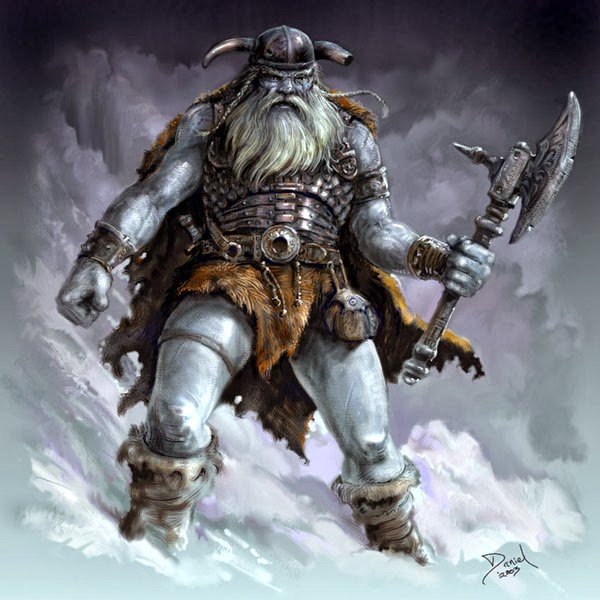
The Giants, sworn enemies of men and of Æsir, were savage and violent but not always malicious. On occasion they might even manifest downright simplicity and good nature. They were of monstrous size, they often had several heads and hands, and they had dark skin and hair. Many of their women were well-favored, as for example Gerd; others again were most hideous: one might have a tail, another two heads, and so forth. The Giants owned great herds of cattle, bulls with gold horns, sheep, horses, and dogs. They loved darkness and the deeds of darkness; their women, avoiding the light of day, were in the habit of riding forth by night, and so they were sometimes called Dark-Riders or Night-Riders. If the sun’s rays chanced to strike a Giant, he turned at once to stone. Now and then it happened that the Giants fought among themselves, throwing huge boulders at one another; but for the most part they were occupied in battle against mankind and the Æsir. The sanctuaries dedicated to the gods were most obnoxious to them, and when the Æsir gave ground before God and his saints, the hatred of the Giants spent itself on the newer deities. Long after the introduction of Christianity, the Giants survived in popular beliefs, and a multitude of legends bear witness to the hostility of the Giants against churches and church bells. To this day in many localities legends are current connected with great boulders or even mountains which are said to have been hurled at churches by the Giants. In earlier times they had as opponents Thor and Odin; later they did battle with mighty saints, with the archangel Michael, and above all with Saint Olaf. To the present day, tradition has preserved legends about fat and well-fed cattle — always black — owned by Mountain-Trolls or Jutuls, about Giant women with long tails which they find it impossible to conceal, and about the malice and stratagems of these beings toward mankind, whom they frequently entice to themselves into the mountains.
The Giants were skilful builders, wise and experienced in all the occult arts. When they became angry, a so-called Giant valor seized them which made their strength double what it was before. As already explained, the Giants lived in Jotunheim or in mountains lying nearer the haunts of men. More than ordinary fame attaches to Utgard, the Giant counterpart to the Midgard of mankind. The river Iving, which never froze over, marked the boundaries between Giants and gods. When the expeditions into the Arctic seas of the North began, Jotunheim or Giant-land gave its name to a real country: the great Russian steppes about the White Sea or Gandvik (the Bay of Trolls), or more particularly the regions bordering on the river Dwina. Here ruled the Giant kings, Geirrœd and his brother Godmund of Glæsisvoll; and many a daring voyager who visited them had surpassing dangers to encounter. The actual ruler of Utgard, however, was the crafty Utgard-Loki.

Comments
Post a Comment